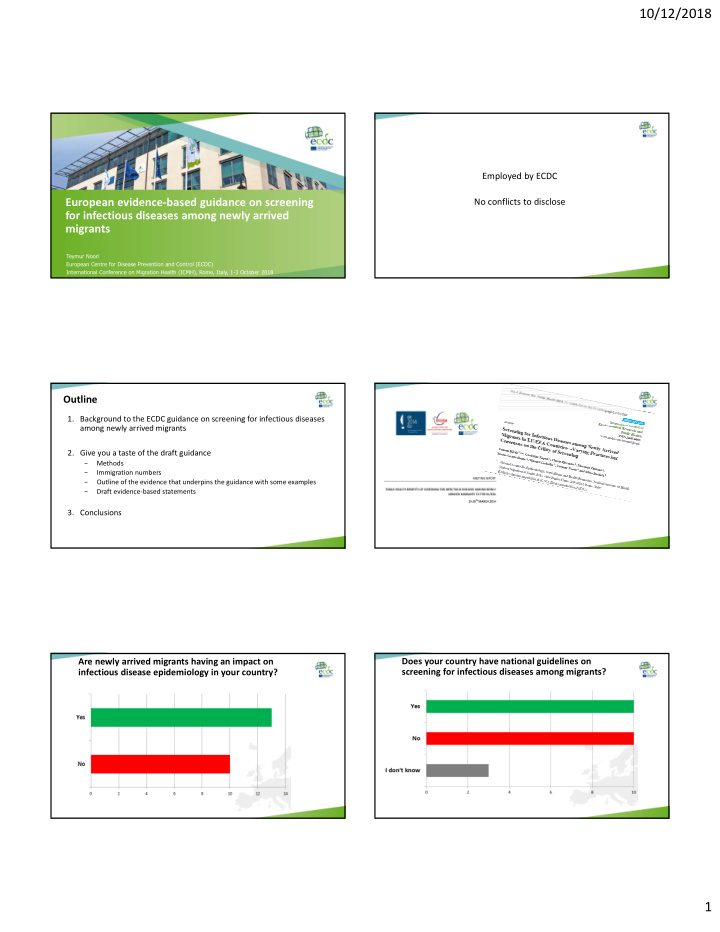



10/12/2018 Employed by ECDC European evidence‐based guidance on screening No conflicts to disclose for infectious diseases among newly arrived migrants Teymur Noori European Centre for Disease Prevention and Control (ECDC) International Conference on Migration Health (ICMH), Rome, Italy, 1-3 October 2018 Outline 1. Background to the ECDC guidance on screening for infectious diseases among newly arrived migrants 2. Give you a taste of the draft guidance − Methods − Immigration numbers − Outline of the evidence that underpins the guidance with some examples − Draft evidence‐based statements 3. Conclusions Are newly arrived migrants having an impact on Does your country have national guidelines on infectious disease epidemiology in your country? screening for infectious diseases among migrants? 1
10/12/2018 Which infectious diseases are migrants screened for Would European guidance on screening for infectious in your country? diseases among migrants be useful? Which conditions would you want ECDC to prioritise In 2015, ECDC embarked in a project to: when developing guidance? 1. Synthesise the scientific evidence on screening and prevention for infectious diseases among migrants 2. Review national and international policies, practices and guidelines on screening for infectious diseases among migrants 3. Consult key experts in countries working with prevention of infectious diseases among migrants 4. Develop evidence‐based guidance on screening and prevention of infectious diseases among newly arrived migrants ECDC Scientific Panel Two scientific panel meetings Angel Kunchev – Bulgaria Maria Axelsson – Sweden 1 st Scientific panel 2 nd Scientific panel meeting (Nov 2015) meeting (Oct 2016) Gabrielle Jones – France Manuel Carballo – Switzerland Anna Kuehne – Germany Sonia Dias – Portugal Henrique Barros – Portugal Agoritsa Baka – Greece Apostoles Veizis – Greece Ines Campos‐Matos – United Kingdom Lelia Thornton – Ireland Dominik Zenner – United Kingdom Cliona M Cheallaigh – Ireland Manish Pareek – United Kingdom Silvia Declich – Italy Rebecca Hall – United Kingdom Francesco Castelli – Italy OBSERVERS Pierluigi Lopalco – Italy Isabel de la Mata – European Commission Michael Vonk – Netherlands Olga Gorbacheva – IOM Joao Pires – WHO Regional Office for Europe Maria van den Muijsenbergh – Netherlands Irene Veldhuijzen – Netherlands Ludovica Banfi – EU Fundamental Rights Agency Reports available from: https://www.researchgate.net/profile/Teymur_Noori 2
10/12/2018 Priority conditions in ECDC guidance Key overarching questions Should newly arrived migrants be offered screening for active TB, LTBI, Active TB Latent TB HIV HIV, hepatitis B, hepatitis C, strongyloidiasis, and schistosomiasis? Who should be targeted and how? Intestinal parasites Should newly arrived migrants be offered vaccination for measles, Hepatitis B Hepatitis C mumps, rubella, diphtheria, tetanus, pertussis, polio, Haemophilus • Schistosomiasis • Strongyloidiasis influenzae type B [HiB] and hepatitis B? Routine vaccinations What are the implementation considerations in EU/EEA countries? •Measles • Diphtheria •Mumps • Tetanus •Rubella • Pertussis •Hib • Polio Methods Annual immigration to the EU/EEA, 2008‐2017 Phase 1 : conduct a systematic Evidence on screening for infectious diseases among 2,500,000 review of reviews and guidelines migrants is limited 2,000,000 Phase 2 : conduct a systematic We have had to rely on indirect evidence, meaning evidence Routine permits (all) search and selection for from general populations that have been extrapolated to Routine permits (≥ 12 months) 1,500,000 economic evaluations on interventions that are targeted toward migrants resource use, costs and cost‐ Asylum applications effectiveness Therefore the certainty of the evidence is ‘low to moderate’ 1,000,000 Int. Protection (all) and the strength of the recommendations are conditional Phase 3 : update systematic on prevalence in country of origin Int. Protection (≥ 12 months) 500,000 reviews of effectiveness Unauthorised landings Very challenging task to develop guidance in the area of 0 migrant health Phase 4 : supplement with de 2008 2009 2010 2011 2012 2013 2014 2015 2016 2017 novo systematic reviews Source: Eurostat. Eurostat migr_resfirst, migr_resoth. [Available from: http://ec.europa.eu/eurostat/statistics‐ explained/index.php/Residence_permits_statistics#First_residence_permits_by_reason. Top 10 countries of births of immigrants and top 10 Active nationalities of asylum seekers (average 2014‐2016) TB * Accessibility Latent Top ten countries of birth of Top ten origins (nationalities) of and TB * acceptability immigrants to the EU/EEA* asylum seekers in the EU/EEA EU/EEA EU/EEA Reviews Important to give Total 1,226,859 % Total 1,037,378 % primary healthcare Intestinal Syria 94,356 8 Syria 270,728 26 HIV * underpinning the workers and policy parasites Afghanistan 137,500 13 China 83,883 7 Methods* makers an indication Iraq 99,930 10 India 77,002 6 guidance of which infectious Morocco 50,469 4 Pakistan 41,447 4 diseases are prevalent Albania 39,595 4 United States 43,132 4 in the countries of Linkage Pakistan 35,764 3 Nigeria 38,535 4 origin, which can guide Hep B * to care * Ukraine 35,384 3 screening efforts at Eritrea 31,682 3 countries of Moldova 29,606 2 Iran 28,159 3 destination Russia 24,976 2 Kosovo 27,200 3 VPD * Hep C * Brazil 24,915 2 Russia 18,121 2 Other 727,371 59 Other 304,482 29 Source: Eurostat migr_asyappctza *Covering 56% of non‐EU/EEA immigrants 3
Recommend
More recommend